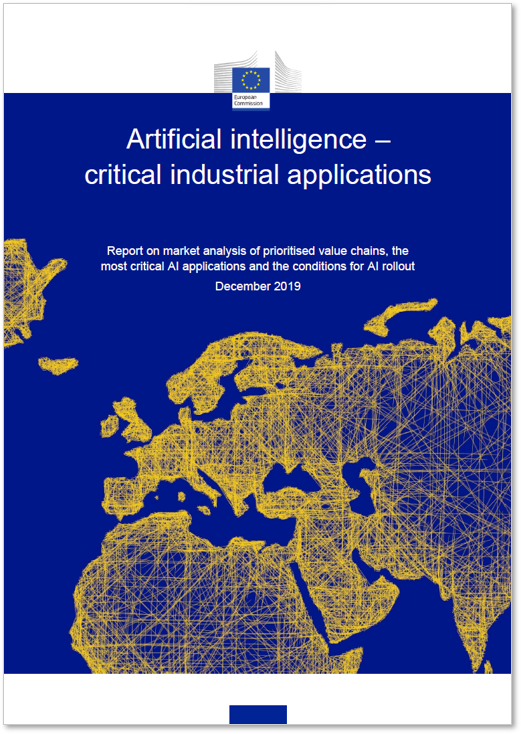
Artificial Intelligence (AI) – Critical Industrial Applications
Advanced artificial intelligence (AI) techniques are no longer a thing of the future. In the past several years, AI has not only moved to the top of the agenda for businesses, but also for policymakers, academic research institutions and the broader public. AI techniques are expected to bring numerous benefits in the form of added value for citizens, higher productivity, improved corporate performance and economic growth. At the same time, AI has the potential to disrupt existing business models, possibly displacing successful ones and impacting the way people live and work. To keep up with the evolution of AI and realise the competitive advantages it can provide, companies need to invest in technology and innovation. This poses a particular challenge for small and medium-sized enterprises (SMEs), which form the backbone of the European economy. Therefore, it is crucial that SMEs are given the best conditions to implement and capitalise on the value of AI applications.
Against this backdrop, EASME and DG GROW aim to identify the optimal mix of industrial policy measures that create a favourable framework for the development and uptake of AI applications by European SMEs, including a successful transition that fully embraces the benefits of AI and mitigates the risks associated with it.
The first part of this report constitutes an in-depth evaluation of three prioritised strategic value chains: the Industrial Internet of Things (IIoT), future mobility and smart health. For each strategic value chain, their core capabilities as well as the relevance of the respective sub-value chains to the EU-28 in terms of employment and economic value added are discussed. The analysis provides a quantitative assessment of the potential impact of AI on the three prioritised strategic value chains. It also discusses the role and relevance of SMEs in the respective strategic value chains and outlines further opportunities for capturing value. Lastly, the analysis assesses the competitiveness of the prioritised value chains in a global context. The following provides a condensed summary of our key findings for each value chain.
IIoT
- The IIoT value chain builds on core capabilities, namely (i) product and service development, (ii) supply chain and production planning, (iii) core production and (iv) after-sales/value-added services, supported and facilitated by (v) key enablers such as cybersecurity or IoT platforms.
- Given the large amount of potentially available data in manufacturing, the potential of AI to increase efficiency, fuel innovation and enable new products, services and business models is huge. Currently, less than 1 per cent of potentially usable data is actually used in IIoT.
- According to the McKinsey Global Institute’s AI use case database, the overall AI impact potential on the IIoT value chain in Europe is estimated at approximately EUR 200 billion. Core production (about EUR 80 billion) and supply chain and production planning (about EUR 70 billion) account for the largest shares.
- Because of a lack of talent, infrastructure and in some cases financing, as well as a limited understanding of AI potential, many SMEs face challenges applying AI. They also face increased competition from born digital SMEs/ start-ups that disrupt all parts of the value chain.
- The environment for AI could be improved in Europe. A global competitivefit analysis of the European IIoT value chain reveals strong performance in research, on-par performance in skills and funding, but lagging performance in regulation and infrastructure dimensions. Future mobility
- The future mobility value chain builds on four sub-value chains, namely (i) vehicles, (ii) mobility services and operations and (iii) infrastructure, interlinked by (iv) data platforms that serve as key enablers of the ecosystem.
- Within the future mobility ecosystem, the vehicles sub-value chain accounts for the highest share of economic value added (3.6 per cent of economic value added in the EU-28, or EUR 479.6 billion), as well as for the highest share of employment (3.3 per cent of employees in the EU-28, or 7.7 million) (Eurostat, 2019).
- According to the McKinsey Global Institute, the AI impact potential on the future mobility value chain is estimated at about EUR 300 billion. The highest AI impact potential was identified within mobility services and operations, coming in at approximately EUR 225 billion, followed by about EUR 70 billion and about EUR 5 billion for vehicles and infrastructure, respectively.
- The ongoing shift from mobility product revenue to mobility service revenue, as well as the emergence of an ecosystem in the supply of digital and nondigital infrastructure, opens up opportunities for SMEs to collaborate with incumbent players, i.e. OEMs.
- The global competitive-fit analysis of the European future mobility value chain reveals strong performance in research and improvement potential in funding, skills and regulation. The value chain is found to be on par with the US and China in terms of infrastructure.
Smart health
- The smart health value chain includes four sub-value chains as its major building blocks: (i) industry, (ii) health service provision, (iii) governance and (iv) administration/payors.
- Health service provision is by far the most important sub-value chain in Europe – from both an economic perspective (a value added of EUR 840.7 billion) and an employment perspective (19.3 million employees in total). It is followed by the industry sub-value chain (Eurostat, 2019).
- According to the McKinsey Global Institute, the overall AI impact potential on the smart health value chain in Europe is estimated at approximately EUR 120 billion – with the biggest impact on health service provision (about EUR 70 billion) and industry (about EUR 20 billion), followed by governance and administration/payors (about EUR 15 billion, respectively)
- The global competitive fit analysis reveals strong performance in research, on-par performance in skills and funding, but lagging performance in regulation and infrastructure.
- The opportunity for AI-enabled process automation in health service provision and the increasing awareness of preventive healthcare represent great value creation potential, especially for smart health start-ups.
The second section of this report contains in-depth analyses of the most critical AI application within each of the three prioritised strategic value chains: IIoT, future mobility and smart health. For each strategic value chain, a longlist of critical industrial AI applications that are already relevant and broadly used or that will soon become relevant and broadly used is created. Each AI application is described based on predefined dimensions (grouped according to the sub-value chain, AI capability used, how it works, examples). Next, the AI applications are prioritised based on a set of criteria that includes expert feedback and the economic relevance of the respective sub-value chains. Lastly, the prioritised AI applications are evaluated based on their social, environmental and economic impact. Thus, the analysis reflects some of the top priorities in the political guidelines of the newly elected European Commission, such as an economy that works for people, the European Green Deal, a Europe fit for the digital age, and a stronger Europe in the world. The following provides a condensed summary of our key findings for each value chain. IIoT
- Overall, we identified 24 relevant AI applications. Three AI applications thereof belong to the product and service development sub-value chain, six to the supply chain and production planning sub-value chain, eight to the core production sub-value chain, six to the after-sales/value-added services sub-value chain and one to the key enablers sub-value chain.
- After the prioritisation of these 24 AI applications, we arrived at a shortlist of eight prioritised IIoT AI applications. One out of these eight AI applications is part of the product and service development sub-value chain, two belong to the supply chain and production planning sub-value chain and five are used within the core production sub-value chain.
- The impact assessment of prioritised AI applications beyond GDP revealed high economic impact potential (as the AI applications significantly contribute to increasing productivity, enhancing process efficiency and reducing cost), highly relevant environmental impact (as the AI applications reduce waste and allow for better use of resources) and – in part – significant social impact (as they improve safety in the workplace, help automate repetitive, physically demanding activities and create more meaningful work tailored to employees’ skills).
Future mobility
- Overall, we identified 23 relevant AI applications in future mobility. Thereof, ten AI applications belong to the vehicles sub-value chain, eight to the mobility services and operations sub-value chain and five to the infrastructure sub-value chain.
- After the prioritisation of these 23 AI applications, we arrived at a shortlist of six prioritised future mobility AI applications. Two out of these six applications are part of the vehicles sub-value chain, three belong to the mobility and services operations sub-value chain and one is used within the infrastructure sub-value chain. Four of these AI applications are product innovations and two represent process optimisation approaches.
- The impact assessment of prioritised AI applications beyond GDP revealed high social impact potential for all six AI applications (e.g. enhanced road safety, fewer traffic accidents and more inclusive mobility), a positive impact on our climate (e.g. reduced pollution, energy consumption and congestion) as well as a positive economic impact (e.g. reduced maintenance or overall costs, enhanced productivity of drivers/commuters).
Smart health
- Overall, we identified 29 relevant AI applications in smart health. Thereof, four AI applications belong to the industry sub-value chain, 16 to the health service provision sub-value chain, seven to the governance sub-value chain and two to the administration/payors sub-value chain.
- After the prioritisation of these 29 AI applications, we arrived at a shortlist of seven prioritised smart health AI applications. Six out of the seven are part of the health service provision sub-value chain, one belongs to the governance sub-value chain. Three of these AI applications are product innovations and four represent process optimisation approaches.
- The impact assessment of prioritised AI applications beyond GDP revealed both high social impact (e.g. significant contribution to the well-being/health of individuals, considerable improvement of public health) and high economic impact potential (e.g. decreased healthcare [delivery] costs) for all seven prioritised AI applications. The environmental impact of the selected AI applications is less important and mostly indirect.
The analysis of the conditions for rollout of the most critical AI applications reveals that the major general barriers to AI adoption perceived by European SMEs include uncertain/only long-term return on investment, missing business cases, lack of digital/managerial skills and lack of access to external funding. The analysis also touches upon specific barriers that European SMEs see as particularly relevant within their respective strategic value chains. In a next step, the analysis highlights that policymakers can also support the adoption and rollout of AI by fostering specific AI enablers. These include digital absorption, innovation foundation, human capital, connectedness and labour market structure and flexibility. Based on the identified barriers and enablers, opportunities to accelerate the rollout of AI in Europe are analysed in a forward-looking SWOT analysis. The analysis reveals Europe’s strong research landscape as a significant strength, its scattered and uncertain regulatory landscape in critical areas for AI rollout as one critical weakness, its increasing pool of digital talent as a great opportunity and its widening gap in digital/AI patents as a threat that should not be neglected. As both barriers and enablers are not AI-application specific, the analysis shows five highpriority policy domains to support both the development and deployment of AI in Europe. These include transparent and easy access to public funding, support of data exchange, enablement of learning and networking among stakeholders, promotion of the development of AI-relevant skills and fostering a more positive attitude towards AI. The analysis closes with potential actions that policymakers can take across these five policy domains for the AI application of autonomous driving.






Artificial Intelligence (AI) – Critical Industrial Applications 0 reviews
Login to Write Your ReviewThere are no reviews yet.